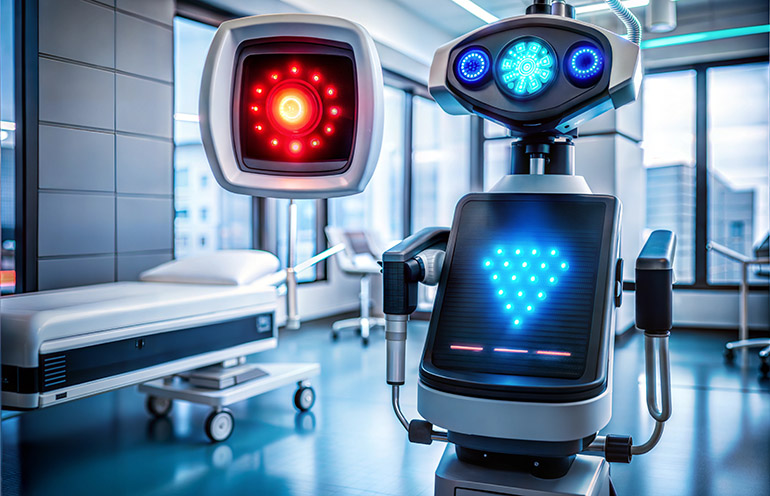
AMD said its processors enable robotic surgery such as with Intuitive Surgical’s da Vinci system. Source: AMD
The need for robotic surgery is well established, but most systems are still costly to purchase, operate, and maintain, noted Advanced Micro Devices Inc. The company said its technologies can help control those costs, and AMD is already working with leading surgical robot providers.
In 2021, almost 644,000 robotic surgeries were performed in the U.S., and that number could reach 1 million in 2028, according to the National Library of Medicine (NLM).
The global market for robot-assisted surgery could grow to $83 billion by 2032, predicted Noah Medical. However, many technical and regulatory hurdles remain to increasing autonomy, noted MDPI Sensors, and cost is a major consideration for adoption.

Surgical robots and related technologies are moving along Gartner’s “hype cycle.” Source: MDPI Sensors
AMD positions itself in the healthcare tech stack
“AMD is one of the fastest-growing semiconductor companies and has grown substantially in the healthcare space,” said Subh Bhattacharya, lead for healthcare and sciences at AMD. “We have a wide portfolio of processors, FPGAs, GPUs, CPUs, SoCs, PLCs, and programmable I/Os. They’re used in industrial automation, automotive, gaming, servers and data centers, and increasingly in healthcare.”
Bhattacharya has an electrical engineering background and worked for Intel, Sun, and PMC. He later worked on software-as-a-service (SaaS) for hospitals; with pharmaceutical company Novartis on medical devices; and with GE Digital on the Internet of Things (IoT), healthcare, and cybersecurity.
After working at Xilinx, which AMD acquired in 2022, Bhattacharya has seen the applicability of high-performance computing to robotic surgery.
“The FDA used to be conservative, but it has started to consider software in medical devices, which were previously under OEM auspices,” he told The Robot Report. “That opens up the technology, as artificial intelligence appears in almost every phase of the industry, from ECR [electronic case reporting] to surgical robots.”

AMD makes processors for data centers, gaming, PCs, and increasingly embedded computing such as surgical robots. Source: AMD
Pandemic propels telemedicine, robotic surgery
“COVID-19 was a market-changer,” observed Bhattacharya. “If you looked at PoC [point-of-care] projections in 2013 for AI, remote patient monitoring, telemedicine, and robotic surgery, they were expected to grow, but it wasn’t happening. COVID accelerated these, and people saw with their own eyes how effective something like point-of-care ultrasound could be in saving lives.”
He cited the example of an AMD customer that built a handheld device with AI capabilities for local physicians without sonography experience. They can now check complaints of back pain for potential cancer and then refer patients as needed to hospitals in cities.
“AMD is building adaptive SoCs [system-on-chips] that have low latency and high-speed data processing from the edge,” Bhattacharya said. “Once AI developers have trained models, they can do a lot more with inferencing with smaller devices.”
Intuitive Surgical robots get improved sensing, controls
“Diagnostic medical imaging has been AMD’s strength — in cart-based care, ultrasound, diagnostic endoscopy, and signal processing,” asserted Bhattacharya. “In robotics, we’re the market leader, and we’ve been working with Intuitive Surgical since 2010.”
The company‘s Xilinx unit worked with Intuitive Surgical to design the second-generation da Vinci robotic surgical system. Last year, more than 7,500 da Vinci systems were in use in 69 countries, said the NLM.
“Intuitive has built up its IP [intellectual property] with design and reuse potential,” Bhattacharya said. “In its surgeon side-cart AR/VR [augmented/virtual reality] system, a visualization system processes the image signal and makes it available for the next set of modules.”
“On the multi-arm robot side, nurses control the technologies with SoCs, and back-end video systems use not just one or two of our products but 30 to 50 per each da Vinci X or Xi multiport and single-port system,” he said. “The da Vinci 5 is a significant step forward in terms of haptic feedback.”
The da Vinci 5 this year obtained U.S. Food and Drug Administration and European CE clearance.
Processors enable a range of medical devices
Reliable data processing is not only necessary for high-end surgical robots, but it can also help less-expensive devices, said Bhattacharya.
“Capable hardware allows customers to scale software as they build up — we’ve provided SoCs to $10,000 to $150,000 machines,” he said. “For small and midsize enterprises, the ability to build and reuse app code is the secret sauce for developers.”
Bhattacharya touted the density of AMD’s FPGA (field-programmable gate array), its fast memory access, and the ability of adaptive SoCs to partition-load to various blocks for programmability and upgradeability.
“For example, a large CT or ultrasound scanner can acquire signals with an analog/digital interface, then use beamforming to move the data to the host for rendering and visualization,” he explained.
The right processors can reduce latency and help accelerate development of medical devices such as endoscopes and surgical robots. AMD said its heterogeneous approach to specialized and adaptable computing allows developers to choose from a range of systems for real-time visualization and multi-axis robot controls.
“With a bigger device and our Embedded+ offering — an x86 processor next to one of our high-end PCI Express in between adaptive SoCs — we can help cut 10 months off development time and provide software for moving data and partitioning,” Bhattacharya said.
AI to improve the quality of robotic surgery
“Robot-assisted surgery provides a clear advantage of smaller incisions and faster recovery,” said Bhattacharya. “The preferred approach of the FDA is to use AI to improve productivity while minimizing risk, so we still see a lot of assistance rather than AI making decisions.”
In addition to diagnostics, AI and machine learning can improve contrast or add filters for surgical robot displays, which don’t require FDA approval, he noted.
“Another use of is AI is for training. I was at a radiological conference, and a demo showed the layman where to put a device to take a report on the carotid artery,” Bhattacharya recalled. “Improving PoC training is low-hanging fruit, but it’s extremely important for medicine.”
Another area where AMD’s processors can enable AI and improve care is in imaging of small lesions to detect skin cancer at early stages, he said.
In the future, AI could even enable PoC surgery, but cybersecurity and surgeon oversight are still necessary for robotic and laparoscopic procedures, acknowledged Bhattacharya.

 2 months ago
50
2 months ago
50









 English (US) ·
English (US) ·